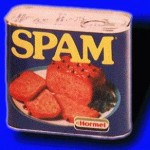 A particularly egregious piece of junk e-mail showed up in my Inbox this morning, and I remarked out loud, “How did this piece of junk get through my spam filter?” I deleted the message, but then started thinking about the word spam. Why do we call unwanted junk email “spam?” I remember the canned meat product, Spam, from childhood days. How did we get from canned meat to junk mail? My curiosity got the better of me, and I did some research.
A particularly egregious piece of junk e-mail showed up in my Inbox this morning, and I remarked out loud, “How did this piece of junk get through my spam filter?” I deleted the message, but then started thinking about the word spam. Why do we call unwanted junk email “spam?” I remember the canned meat product, Spam, from childhood days. How did we get from canned meat to junk mail? My curiosity got the better of me, and I did some research.
 Let’s start with the canned meat product, Spam (shortened from spiced ham), produced by the Hormel Foods Corporation. Hormel has produced Spam since 1937. The labeled ingredients in the classic variety of Spam are chopped pork shoulder meat, with ham meat added, salt, water, modified potato starch as a binder, and sodium nitrite as a preservative. Spam slips out of the standard size 12-ounce can covered with a gelatinous glaze, or aspic, formed from the cooling of meat stock. Much to Hormel’s chagrin, Spam has become part of many jokes and urban legends about mystery meat, and firmly ensconced Spam as part of pop culture and folklore.
Let’s start with the canned meat product, Spam (shortened from spiced ham), produced by the Hormel Foods Corporation. Hormel has produced Spam since 1937. The labeled ingredients in the classic variety of Spam are chopped pork shoulder meat, with ham meat added, salt, water, modified potato starch as a binder, and sodium nitrite as a preservative. Spam slips out of the standard size 12-ounce can covered with a gelatinous glaze, or aspic, formed from the cooling of meat stock. Much to Hormel’s chagrin, Spam has become part of many jokes and urban legends about mystery meat, and firmly ensconced Spam as part of pop culture and folklore.
In the 75 years since its introduction, Hormel has introduced ten additional varieties of Spam, including Hot and Spicy, Spam with Bacon, and Spam with Cheese. To celebrate Spam’s 75th anniversary, Hormel created a website totally devoted to SPAM.
Some interesting Spam facts I tripped over during my research:
- Spam is sold in 41 countries, on six continents (no grocery stores in Antarctica?)
- In 2007, the 4 billionth can of Spam was sold
- 3.8 cans of Spam are consumed every second in the US
- On average, each person on Guam consumes 16 tins of Spam each year
 But none of this explains the connection between the canned meat product and the totally undesirable and definitely unwanted clutter in my junk mail folder. To find that connection, we have to go back to 1970, to a sketch from the British television series, Monty Python’s Flying Circus, in which Spam is portrayed as ubiquitous and inescapable. Rather than describing the sketch, here is a link so you can watch it for yourself.
But none of this explains the connection between the canned meat product and the totally undesirable and definitely unwanted clutter in my junk mail folder. To find that connection, we have to go back to 1970, to a sketch from the British television series, Monty Python’s Flying Circus, in which Spam is portrayed as ubiquitous and inescapable. Rather than describing the sketch, here is a link so you can watch it for yourself.
After the invention of the Internet (by Al Gore?) some years later, marketers began drowning out discourse by flooding Usenet newsgroups and individuals’ email with junk mail advertising messages. This phenomenon was named spamming, due to some early internet users that flooded forums with the word spam, recounting the repetitive and unwanted presence of Spam in the Monty Python sketch.
Now, you might think that Hormel would have been more than a bit miffed by the take-off on one of their headline products, but you’d be wrong. Though the company was never particularly happy about the use of the word spam for junk email, Hormel has been supportive of Monty Python and their sketch. Hormel issued a special tin of Spam for the Broadway premiere of Eric Idle’s hit musical Spamalot. Also, the sketch is part of the company’s Spam museum in Austin, Minnesota.
In 2007 the Hormel company decided that the spam publicity was part of their corporate image, possibly for the better, and sponsored a game where their product is strongly associated with Monty Python, even featuring a product with “Stinky French Garlic” as part of the promotion of Spamalot. If there is a lesson in all of this, and I’m sure there is, it must be that it is often best to take advantage of whatever life throws in front of you, even if you don’t like it at first. You may be much better of simply utilizing the situation to your best advantage, rather than opting to fight what may ultimately be a losing battle.
And while you are musing on all of this, go ahead; click on the link and play the game. Allow yourself one of life’s small pleasures. I promise not to tell.
Dave — I grew up loving Spam. My mom made a dinner called Spamettes. She’d chop or grind Spam with onions, green pepper, and cheese (Velveeta?), and then spread it on half an English muffin. The Spamettes were placed in the oven, and a few minutes later out they would come to be devoured by hungry teens. — Rudi